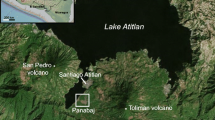Abstract
A numerical model is used to simulate channelized lahars, flowing with a near-constant sediment concentration and volume. Water and debris are usually mobilized in short times and the peak discharge of lahars may reach many thousands of cubic meters per second in a few minutes. A relation for the energy dissipation term must be provided in the model, which in turn depends on debris flow rheology and shape and status of channel bed. A discussion of the form of this term is performed through the simulation of some historical (among the well-documented) lahars and lahar-runout flows with concentrations ranging in a wide spectrum up to 70 percent by volume and irregularly shaped sand and coarser particles dispersed in a fluid matrix of water and fine material. As concentration increases and turbulence decreases, the dissipative term, which, in the first case, is proportional to the square average flow velocity (Manning or Chezy formulation) is well described by a linear dependence on flow velocity, as expected in the laminar case. The numerical reproduction of the examined historical cases suggests that the model can be used for hazard assessment, if some hypotheses are made about lahar hydrograph at the source, its volume, and the shape of the dissipative term.
Similar content being viewed by others
References
Barberi F, Caruso P, Macedonio G, Pareschi MT and Rosi M (1992) Reconstruction and numerical simulation of the lahar of the 1877 eruption of Cotopaxi volcano (Ecuador). Acta Vulcanol 2:35–44
Chen C (1987) Comprehensive review of debris flow modelling concepts in Japan. Rev Eng Geol 7:13–29
Chen C (1988) General solution of the viscoplastic debris flow. J Hydrual Eng 114:259–282
Cummans J (1981a) Mudflows resulting from the May 18, 1980, eruption of Mt. St. Helens, Washington. US Geological Survey Circular 850-B. 16 pp
Cummans J (1981b) Chronology of mudflows on the South Fork and North Fork Toutle River following the May 18 eruption. In: Lipmann PW and Mullineaux DR (Eds), The 1980 Eruption of Mount St. Helens, Washington. US Geological Survey Professional Paper 1250. pp 479–486
Fairchild LH (1987) The importance of lahar initiation process. In Costa JE and Wieczorek GF (Eds), Debris flows/avalanches: Process recognition and mitigation. Rev Eng Geol 7:51–61
Janda RJ, Scott KM, Nolan KM and Martinson HA (1981) Lahar movement, effects, and deposition. In Lipmann PW and Mullineaux DR (Eds), The 1980 Eruption of Mount St. Helens, Washington. US Geological Survey Professional Paper 1250. pp 461–478
Laenen A and Hansen RP (1988) Simulation of three lahars in the Mount St. Helens area, Washington using a one-dimensional, unsteady-state streamflow model. US Geological Survey, Water-Resource Investigations Report 88-4004. 20 pp
Li J and Luo D (1981) The formation and characteristics of mudflow and flood in the mountain area of the Dachao River and its prevention. Z Geomorphol 25:470–484
Li J, Yuan J, Bi C and Luo D (1983) The main features of the mudflow in Jiang-Jia Ravine. Z Geomorphol 27:325–341
Macedonio G and Pareschi MT (1992) Numerical simulation of some lahars from Mt. St. Helens. J Volcanol Geotherm Res (in press)
Major JJ and Pierson TC (1992) Debris flow rheology: Experimental analysis of fine-grained slurries. Water Resour Res 28(3):841–857
Neall VE (1976) Lahars as major geological hazards. Bull Int Assoc Eng Geol 14:233–240
Paterson BR (1976) The effects of lahar from the 1975 April Mt Ruapehu eruption and the threat of future eruption on Tongariro power development. NZ Geological Survey Unpublished Engineering Geology Report EG 230
Pierson TC (1985) Initiation and flow behavior of the Pine Creek and Muddy River lahars, Mt. St. Helens, Washington. Geol Soc Am Bull 96:1056–1069
Pierson TC (1986) Flow behavior of channelized debris flows, Mount St. Helens, Washington. In Abrahams AD (Ed), Hillslope processes. Boston: Alien & Unwin. pp 269–296
Pierson TC and Scott KM (1985) Downstream dilution of a lahar: Transition from debris flow to hyperconcentrated streamflow. Water Resour Res 21(10):1511–1524
Pierson TC, Janda RJ, Thouret JC and Borrero CA (1990) Perturbation and melting of snow and ice by the 13 November 1985 eruption of Nevado del Ruiz, Colombia, and consequent mobilization, flow and deposition of lahars. J Volcanol Geotherm Res 41:17–66
Scott KM (1988) Origin, behaviour, and sedimentology of lahars and lahar-runout flows in the Toutle-Cowlitz River system. US Geological Survey Professional Paper 1447-A. 74 pp
Smart GM (1984) Sediment transport formula for steep channels. J Hydraul Div ASCE 110(3):267–276
Takahashi T (1987) High velocity flow in steep erodible channels. In Fluvial Hydraulics, Proceedings of the 22nd IAHR Congress, Lausanne, Switzerland, pp 42–53
Takahashi T (1991) Debris flow. Balkema AA (ed.), Rotterdam: IAHR Monograph Series. 165 pp
Vignaux M and Weir GJ (1990) A general model for Mt. Ruapehu lahars. Bull Volcanol 52:381–390
Weir JG (1982) Kinematic wave theory for Ruapehu lahars. NZ J Sci 25:197–203
Yokoyama I, Tilling RI and Scarpa R (1984) International mobile early-warning systems (s) for volcanic eruptions and related seismic activities. Paris: UNESCO FP/2106-82-01(2286). 102 pp
Author information
Authors and Affiliations
Rights and permissions
About this article
Cite this article
Caruso, P., Pareschi, M.T. Estimation of lahar and lahar-runout flow hydrograph on natural beds. Geo 22, 141–152 (1993). https://doi.org/10.1007/BF00789326
Received:
Accepted:
Issue Date:
DOI: https://doi.org/10.1007/BF00789326




